Berlin: An Urban Futurescape
My second visit to Berlin is haunting me. I think I’m glimpsing our collective future here. The evidence wasn’t in the obvious things—the daring architecture and rebuilt Potsdamer Platz, site of the old wall—but in the corners and crevasses, the young people, and the Michelberger Hotel!
Rachel Smith (Grove Director of Digital Facilitation), Gisela Wendling (the Grove’s Director of Global Learning and a native of the area near Cologne), and I were in Berlin for The Grove’s Advanced Visual Facilitation Workshop, scheduled to coincide with the EuroViz conference the following week.
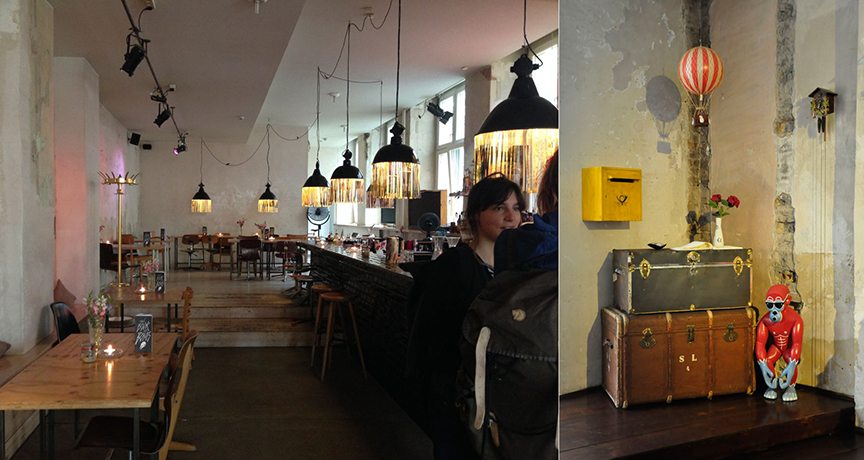
(We’re repeating in August in SF FYI). Thanks to Guido Neuland, one of the co-sponsors of EuroViz, we were based at the Michelberger Hotel, an extraordinarily imaginative place built by and for young people into the music and art scene. Here’s a composite picture of the bar and one of the many art installations.
We landed on the night of the final match between Germany and Argentina for the World Cup. We got to watch it in the packed bar—imagine a hi-def screen at the far end with every inch of the space filled with excited young Berliners. We didn’t get much sleep that night—the city was in fugue!
The next day we enjoyed the courtyard of the Michelberger,  crisscrossed with flags from the many weeks of game-watching and celebration at Germany’s victories. As the flags rustled in the wind, I kept thinking I was praying in Tibet or near a stream.
crisscrossed with flags from the many weeks of game-watching and celebration at Germany’s victories. As the flags rustled in the wind, I kept thinking I was praying in Tibet or near a stream.
Behind me to the right is the corner of an entry way that is built entirely out of old windows. On one of the larger ones was the image of an amusement park, with a fussball as the focal image. It captures the feeling I had as I opened to overwhelming amounts of visual stimulation everywhere I looked in this city.
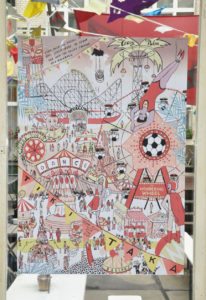 I’ll make another post about our workshop—it was special, with a dozen people from all over the world. This post is about Berlin itself, which we were able to explore for several days while adjusting to the new time zone.
I’ll make another post about our workshop—it was special, with a dozen people from all over the world. This post is about Berlin itself, which we were able to explore for several days while adjusting to the new time zone.
What I kept thinking about this trip was transformation—not just because I was with Gisela who has a PhD. on the subject, and because The Grove is increasingly leaning into this kind of work—but because the evidence was so, may I coin a word, graphic! It was everywhere.
This image of a wall of graffiti rising above a tiny vacant lot, full of vibrant green living things speaks to my “seeing.” Graffiti is everywhere, and it’s clearly going well beyond tagging walls, although there is a lot of that. 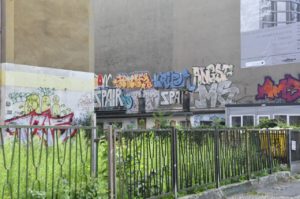 I saw spasms of color and expression pushing against stone, against rules, against habits. I could imagine the artists themselves dancing their creations into being, playing with the interdependence between the large, predictable structures they paint on and the jazz-like improvisations emerging from the symbolic realm.
I saw spasms of color and expression pushing against stone, against rules, against habits. I could imagine the artists themselves dancing their creations into being, playing with the interdependence between the large, predictable structures they paint on and the jazz-like improvisations emerging from the symbolic realm.
It’s not all artful. This graffiti is at the top of the escalator leading to the U2 train that went downtown. Its shiny predictability, reflected in the escalator itself, interleaves with the chaos and cries that lodge on the rougher surfaces.
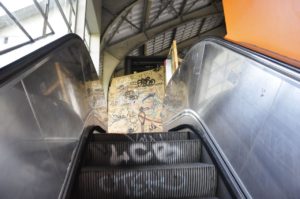 I didn’t intend to get so involved with urban graffiti, but it kept talking to me of the future we are moving into. It is a future where having voice is important, almost in direct proportion to how swiftly the big structures move, as they have always moved, toward predictability and security.
I didn’t intend to get so involved with urban graffiti, but it kept talking to me of the future we are moving into. It is a future where having voice is important, almost in direct proportion to how swiftly the big structures move, as they have always moved, toward predictability and security.
Here are a final couple of images that play with this theme. 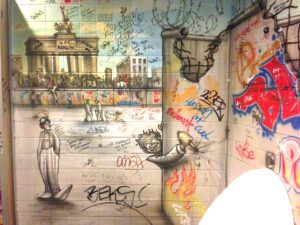 One is of the best bathroom graffiti I’ve ever seen, capturing so much of what I was experiencing. It’s an homage to the falling of the Berlin Wall. I love the clown. I love the pen wielding young person, crazed with excitement.
One is of the best bathroom graffiti I’ve ever seen, capturing so much of what I was experiencing. It’s an homage to the falling of the Berlin Wall. I love the clown. I love the pen wielding young person, crazed with excitement.
It wasn’t much after seeing this that we walked out onto Unter den Linden in front of the real Brandenberg Gate and encountered hundreds of Polizei in dark uniforms and belts full of tasers and batons surrounding a group of maybe 150 young people protesting Germany’s support of Israel in the fight with Gaza. The demonstration was peaceful, but the show of force the kind of thing I’ve only seen before in Chicago during the Democratic National Convention in 1967. These young know there is something terribly wrong in what is happening in the Middle East, just as my generation did about Vietnam. But perhaps the police were there because in the morning hundreds of thousands were in the city to greet the world’s top Fussball team returning from Rio. Keeping order is probably a necessary passion when so many forces of change are afoot.
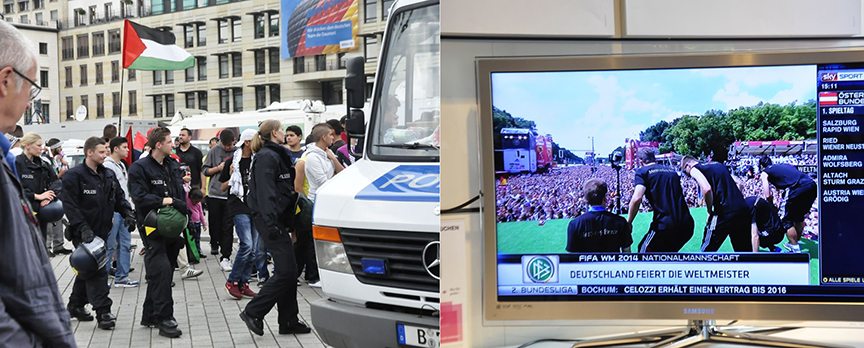
I suspect the future is more like Berlin than the relatively undisturbed cities in North America. This city was cracked open, and released were equal parts desire to reclaim and reconstruct on the one hand and to move into new territory and innovate on the other. At the Michelberger I felt the beauty that arises from innovating with everyday, found objects through good design and surprise—repurposing the old—inviting in the new. In Potsdamer Platz riding the fastest elevator in Europe up to a panorama I felt the thrill of a disciplined engineering culture that rebuilt this bombed out city. And in the spontaneous concerts that seemed to arise every humid night out by the Warschauerstrasse stop on the UBahn I felt the irresistible pushing up of new life that the young bring where ever they are.
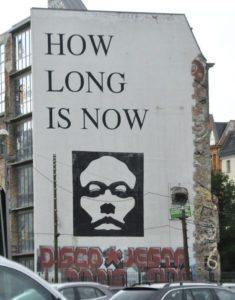 This final image, painted on the side of an old East Berlin set of artist’s lofts, sums it up for me. How long is now? How long do we have with how we do it now? How long can we stay present with the real now, the faces of those who don’t have a future, now? “How Long?” is now!
This final image, painted on the side of an old East Berlin set of artist’s lofts, sums it up for me. How long is now? How long do we have with how we do it now? How long can we stay present with the real now, the faces of those who don’t have a future, now? “How Long?” is now!


No Comments